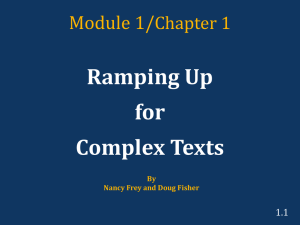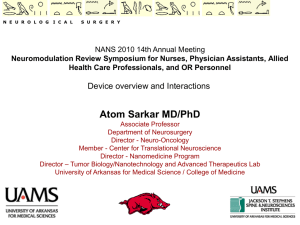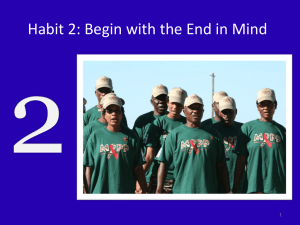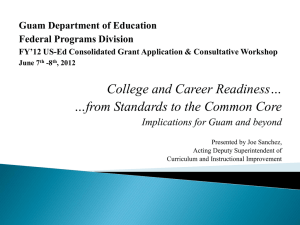OEU1 2A Intro to Daily 5
advertisement
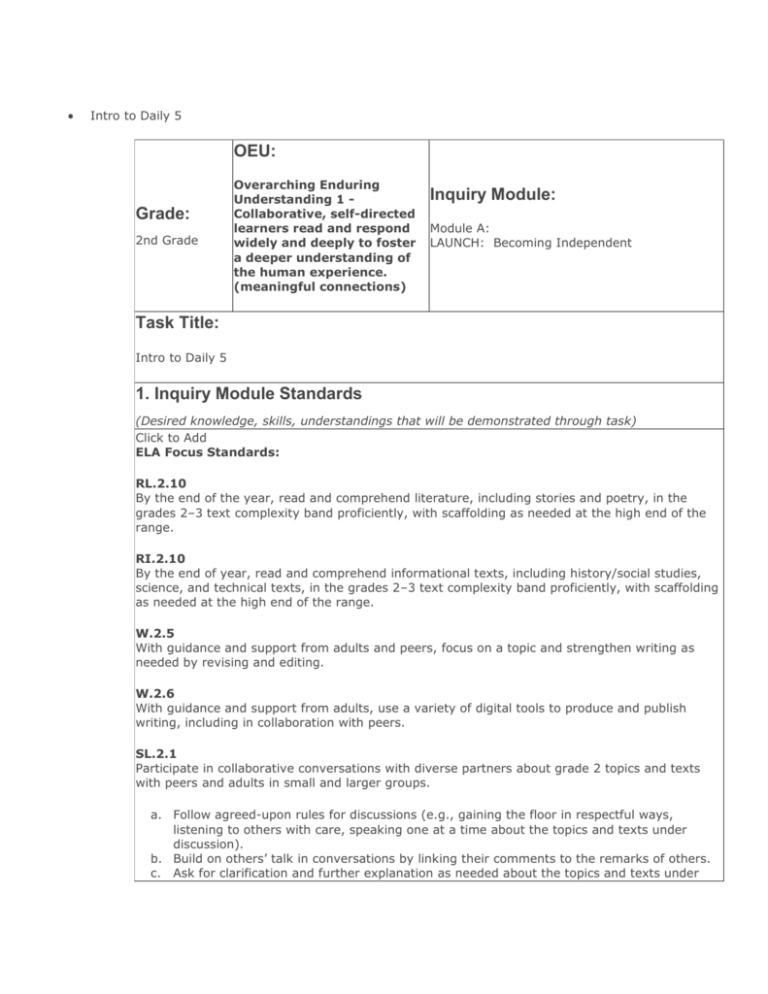
Intro to Daily 5 OEU: Grade: 2nd Grade Overarching Enduring Understanding 1 Collaborative, self-directed learners read and respond widely and deeply to foster a deeper understanding of the human experience. (meaningful connections) Inquiry Module: Module A: LAUNCH: Becoming Independent Task Title: Intro to Daily 5 1. Inquiry Module Standards (Desired knowledge, skills, understandings that will be demonstrated through task) Click to Add ELA Focus Standards: RL.2.10 By the end of the year, read and comprehend literature, including stories and poetry, in the grades 2–3 text complexity band proficiently, with scaffolding as needed at the high end of the range. RI.2.10 By the end of year, read and comprehend informational texts, including history/social studies, science, and technical texts, in the grades 2–3 text complexity band proficiently, with scaffolding as needed at the high end of the range. W.2.5 With guidance and support from adults and peers, focus on a topic and strengthen writing as needed by revising and editing. W.2.6 With guidance and support from adults, use a variety of digital tools to produce and publish writing, including in collaboration with peers. SL.2.1 Participate in collaborative conversations with diverse partners about grade 2 topics and texts with peers and adults in small and larger groups. a. Follow agreed-upon rules for discussions (e.g., gaining the floor in respectful ways, listening to others with care, speaking one at a time about the topics and texts under discussion). b. Build on others’ talk in conversations by linking their comments to the remarks of others. c. Ask for clarification and further explanation as needed about the topics and texts under discussion. L.2.1 Demonstrate command of the conventions of standard English grammar and usage when writing or speaking. a. Use collective nouns (e.g., group). b. Form and use frequently occurring irregular plural nouns (e.g., feet, children, teeth, mice, fish). c. Use reflexive pronouns (e.g., myself, ourselves). d. Form and use the past tense of frequently occurring irregular verbs (e.g., sat, hid, told). e. Use adjectives and adverbs, and choose between them depending on what is to be modified. f. Produce, expand, and rearrange complete simple and compound sentences (e.g., The boy watched the movie; The little boy watched the movie; The action movie was watched by the little boy). L.2.6 Use words and phrases acquired through conversations, reading and being read to, and responding to texts, including using adjectives and adverbs to describe (e.g., When other kids are happy that makes me happy). Click to Add ELA Reading Foundational Skills Standards: RF.2.3 Know and apply grade-level phonics and word analysis skills in decoding words. a. b. c. d. e. f. Distinguish long and short vowels when reading regularly spelled one-syllable words. Know spelling-sound correspondences for additional common vowel teams. Decode regularly spelled two-syllable words with long vowels. Decode words with common prefixes and suffixes. Identify words with inconsistent but common spelling-sound correspondences. Recognize and read grade-appropriate irregularly spelled words. RF.2.4 Read with sufficient accuracy and fluency to support comprehension. a. Read on-level text with purpose and understanding. b. Read on-level text orally with accuracy, appropriate rate, and expression. c. Use context to confirm or self-correct word recognition and understanding, rereading as necessary. Click to Add ELA Transfer/Application Standards: 2. TASK DESCRIPTION-2a-2e (short narrative paragraph description) What do independent readers and writers do? Why is it important to build stamina in reading and writing? How do reading preferences help us learn about each other? Second grade readers and writers learn the structure of Daily 5: read to self, read to someone, listen to reading, word work, and work on writing. Students are introduced to the structures, routines, and habits of independent readers and writers. Students listen, read and respond to a variety of literature and informational texts for the purpose of identifying student interests and expanding their knowledge of different genres. Students organize the classroom library with guidance and support by the teacher, identifying categories, authors/illustrators, content, genre, etc. so students can locate texts easily. Students learn to select “good-fit” books and are matched to appropriate texts so that they can read for meaning and fluently apply reading strategies and foundational skills during guided practice. Students use writing and illustrations to express their ideas. Lessons in language/word study are brief, focused, and engaging. Explicit and systematic instruction in phonics, word recognition, and fluency is designed to develop proficient readers with the capacity to comprehend texts appropriate to the grade level. Technology is embedded into instruction whenever possible. 3. TASK SPECIFICS-3a-3c 3a. Task Choice Books, locations, writing topics, word work materials, Daily 5 activity, listening supplies, Read to Someone style 3b. Student Groupings individual, partners, small groups 3c. Task Sequence o Model classroom routines o Introduce Daily 5 structure and parts. o o o o o Model the habits of independent readers and create anchor chart to record expectations. Create anchor chart for “3 Ways to Read a Book” Model how to read and talk about pictures, read words, and retell a previously read book. Discuss reading strategies for independent reading: (accuracy, fluency, and meaning) Create anchor chart for “Where and How to Sit in the Room.” Practice anchor chart behavior. o o Demonstrate how to choose appropriate leveled text, “Good-Fit Books” in five ways and make chart. I PICK: 9. I choose a book 10. Purpose – Why do I want to read it? 11. Interest – Does it interest me? 12. Comprehend – Am I understanding what I am reading? 13. Know – I know most of the words. o o o o o o Introduce classroom library and assist students with making appropriate book choices for their book boxes. (5-10 books) Introduce and discuss appropriate “Read to Self” expected behaviors Make “Read to Self” anchor chart. Demonstrate correct and incorrect “Read to Self” behaviors. Model and practice branching out to “Read to Self” and returning to whole group area upon hearing timer. Repeated practice with added minutes each time to build stamina. Model how to engage “Read to Someone” with diverse partners o o o o Think aloud and demonstrate agreed-upon behaviors for speaking and listening by recording on an anchor chart Discuss “Ways to Read to Someone” by making an anchor chart 22. “I Read, You Read,” one book 23. Choral reading same book 24. Two different books Model how to “check for understanding” by asking questions for further clarification in conversation. Model how to choose a partner, location, and to sit EEKK (Elbow to Elbow, Knee to Knee) Model the habits of independent writers and create anchor chart to record expectations. o o o o o o Create anchor chart for “Work on Writing” behaviors Model where and how to sit during “Work on Writing” Brainstorm materials to use during writing Discuss writing strategies and ideas used by independent writers. 1. Underline unsure spellings 2. Applying descriptive words 3. How to write pieces on topics of choice 4. Improve writing by revising and editing Practice anchor chart behavior. Model how to engage in “Word Work” independently, with partner, or in small groups 0. Collaboratively create an anchor chart recording expected behaviors. 1. Brainstorm materials to use during “Word Work” 2. Model and practice materials setup, placement, and cleanup. 3. Practice anchor chart behavior and routine of returning to whole group area. Demonstrate how to apply grade-level phonics and word analysis skills during “Word Work." 34. Demonstrate how to distinguish between long and short vowels when decoding 35. Demonstrate how to apply spelling-sound correspondences for additional common vowel teams when decoding 36. Demonstrate how to recognize irregularly spelled words o o Model how to engage in “Listen to Reading” independently, with partner, or in small groups 38. Collaboratively create an anchor chart displaying expected behaviors. 39. Brainstorm materials to use during “Listen to Reading” 40. Model and practice listening to a short story, finishing it, and starting a new story. 41. Model and practice materials setup, placement, and cleanup. 42. Practice anchor chart behavior and routine of returning to whole group area. o o Practice Daily 5 routines until mastered. Demonstrate how to produce, create, and publish a video or slideshow of Daily 5 routines. Divide into small groups of 4. Choose a Daily 5 routine to model with group and create recording to display their understanding of the learned behaviors. Use recordings to make a slideshow o Share videos or slideshows to given audience. 4. TASK PURPOSE AND AUDIENCE 4a. Purpose The task provides the students with the opportunity to display their knowledge of the Daily 5 organization, routines, and behaviors necessary to be effective readers, writers and language/word work learners. They participate in collaborative conversations to create a slide show demonstrating one area of the Daily 5 structure. Additionally, the slideshow could be shared with students, other classes, teachers, and parents. 4b. Audience Classmates, other classes, teachers, and parents 5. RESOURCES/MATERIALS NEEDED FOR TASK chart paper for anchor charts book boxes writing notebooks word work materials classroom library whole group rug listening area timer/bell flip camera Moviemaker software computers projector Edit 6. ASSESSMENT 6a. Self-Monitoring Methods Check-ins, voice level, Daily 5 independence checklist and goal sheet. 6b. Rubric for Quality individual conferences, reading assessments, teacher anecdotal notes,


